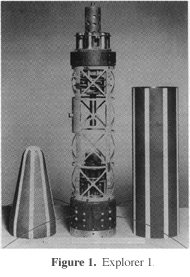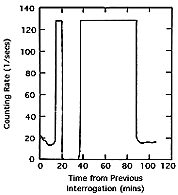
Clicking on any marked section on the list below brings up a
file containing it and all unmarked sections immediately
following it on the list. This list is repeated at the beginning of each file.
|
The mission of Explorer 1 was assembled in a hurry. The US was trailing the USSR in space exploration, and the first attempted launch of its official entry, the Vanguard, ended in flames on the launching pad, and a launch vehicle was therefore improvised from available components, a back-up plan devised earlier by Von Braun [1964; Pickering, 1963]. The resulting orbit was rather non-circular and rose to an apogee of 2500 km, deep inside the radiation belt. Explorer 1 carried a radiation detector, a Geiger counter provided by Van Allen's team at the University of Iowa (Figure 1), which also included Carl McIlwain, Ernie Ray and George Ludwig [Van Allen, 1981, 1983a]. The counter was meant to measure the overall cosmic ray intensity, which by Stoermer's theory [see BH-1] was expected to increase with magnetic latitude, and its predicted counting rate was about 30 counts per second. The experimental package was a modified version of one designed for a later launch in the Vanguard series, and included a tape recorder designed to store the data for retransmission when the spacecraft passed over tracking stations. However, it was decided to provide this feature only on later missions and to omit it from Explorer 1, so that stations were only able to collect a few minutes' worth of data whenever Explorer 1 passed within range.
| 
|

| Explorer 2 failed to orbit, but Explorer 3 was successful. Unlike Explorer 1, it carried a tape recorder, and its continuous record of data (Figure 2) made clear what was happening. At low altitudes, only cosmic rays were detected; then as the satellite rose the recorded counting rate increased up to the highest it could record, and it stayed pegged there for a while. At a still higher altitude it abruptly fell to zero, and during descent the same transitions occurred in reverse order. The periods of zero counts near apogee clearly marked not the absence of radiation but a very high radiation flux: the Geiger counter was discharged so frequently that it did not recover between pulses and its output signals decreased until they no longer triggered the counting circuit.
|
In conclusion, it should be stressed here that the above is a very abbreviated summary of a complex period of discovery, and a much more detailed picture is available from Van Allen [1983a].
"Exploration" home page ......... "Exploration" index
 Official GSFC Home Page .........
Official GSFC Home Page .........
 NASA WWW Home Page
NASA WWW Home Page
Last updated: October 16,1997